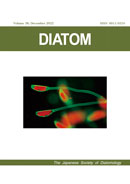38 巻
選択された号の論文の8件中1~8を表示しています
- |<
- <
- 1
- >
- >|
論文
-
2022 年 38 巻 p. 1-13
発行日: 2022年
公開日: 2022/04/23
PDF形式でダウンロード (45943K)
研究ノート
-
2022 年 38 巻 p. 14-17
発行日: 2022年
公開日: 2022/04/23
PDF形式でダウンロード (10350K) -
2022 年 38 巻 p. 18-19
発行日: 2022年
公開日: 2022/06/23
PDF形式でダウンロード (1052K) -
2022 年 38 巻 p. 34-37
発行日: 2022年
公開日: 2022/09/07
PDF形式でダウンロード (1630K)
原著論文
-
2022 年 38 巻 p. 20-33
発行日: 2022/08/17
公開日: 2022/09/07
PDF形式でダウンロード (1129K) -
2022 年 38 巻 p. 38-48
発行日: 2022年
公開日: 2022/09/28
PDF形式でダウンロード (6584K)
短報
-
2022 年 38 巻 p. 49-53
発行日: 2022年
公開日: 2022/10/26
PDF形式でダウンロード (14372K)
原著論文
-
2022 年 38 巻 p. 54-67
発行日: 2022年
公開日: 2023/01/20
PDF形式でダウンロード (21685K)
- |<
- <
- 1
- >
- >|
